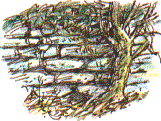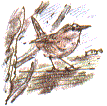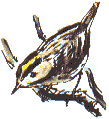Nature Diary Rocks History Gallery Links Home Page  THE FROST SUBSIDES overnight. Back on our usual longer walk, where the lane curves downhill, a drystone wall covered in a pale green lichen supports the hedgebank. It is overhung with Ivy, a few stumpy moss-covered Elders grow by it.
THE FROST SUBSIDES overnight. Back on our usual longer walk, where the lane curves downhill, a drystone wall covered in a pale green lichen supports the hedgebank. It is overhung with Ivy, a few stumpy moss-covered Elders grow by it.Its weathered patina reminds me of walls of the uplands and the wetter west of England. I can feel that I'm in 'real' countryside, countryside with a past, when I glance at that wall.
A Kestrel flies low over peat brown furrows.
Hunting the Wren A Wren hops on a fence by an elder. According to a tradition that seems to go back to the Greeks and Romans, at this time of year the Robin kills the wren, hence his red breast. The origins of the legend seem to refer to the Goldcrest, which, with its bright colours, was identified with the Lord of Misrule of the yule-tide revels, the old king of winter.
A Wren hops on a fence by an elder. According to a tradition that seems to go back to the Greeks and Romans, at this time of year the Robin kills the wren, hence his red breast. The origins of the legend seem to refer to the Goldcrest, which, with its bright colours, was identified with the Lord of Misrule of the yule-tide revels, the old king of winter.
The wren traditionally symbolised winter and the robin summer. On twelfth night in Pembrokeshire, where the song (The King) was collected, a wren was hunted and killed to symbolise the death of winter and then placed in a garlanded box and taken from door to door. At each house this song was sung and the occupants asked to pay to see the dead wren with the words, 'Please to see the King'. In The White Goddess Robert Graves points out the links of this tradition to Saturnalia, the Robin Hood legend and Celtic myths. Another tradition was to stone the wren on St Stephen's Day (Boxing Day), in commemoration of the first Christian martyr. This all sounds like bad news for the wren, but it enjoyed strict protected in every other month of the year, in particular it was very unlucky to take a wren's egg.
|


 In the park a Treecreeper climbs on the trunk of a Syacamore. In the branches above Blue Tits and Great Tits search for food. Mixed groups like this stick together at this time of year. With so many pairs of eyes there's more chance of spotting a predator and, should a predator attack, there's probably more chance of escaping amongst the crowd. It's also possible that an insect disturbed by one bird might be picked up by another.
In the park a Treecreeper climbs on the trunk of a Syacamore. In the branches above Blue Tits and Great Tits search for food. Mixed groups like this stick together at this time of year. With so many pairs of eyes there's more chance of spotting a predator and, should a predator attack, there's probably more chance of escaping amongst the crowd. It's also possible that an insect disturbed by one bird might be picked up by another. Goldcrests aren't always easy to find, so, in folk tradition, the wren, decorated with bright ribbons, took its place. Here's an account given in the sleeve notes for the 1971 Steeleye Span album Please to see the King;
Goldcrests aren't always easy to find, so, in folk tradition, the wren, decorated with bright ribbons, took its place. Here's an account given in the sleeve notes for the 1971 Steeleye Span album Please to see the King;
 But the robin didn't have it all its own way. In Devonshire wren was known as 'Bran's Sparrow' 'the cuddy vran' (Bran was a Celtic god and also the name of the giant Fingal's dog). In the song Who killed Cock Robin it is the sparrow that admits to the crime. Rather like Gawain and the Green Knight they seem to take their turn as victors as summer and winter come and go.
But the robin didn't have it all its own way. In Devonshire wren was known as 'Bran's Sparrow' 'the cuddy vran' (Bran was a Celtic god and also the name of the giant Fingal's dog). In the song Who killed Cock Robin it is the sparrow that admits to the crime. Rather like Gawain and the Green Knight they seem to take their turn as victors as summer and winter come and go.